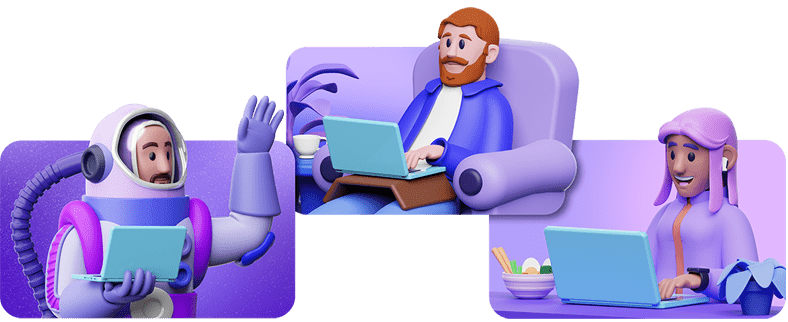What Is Team Collaboration and Why Does It Matter?
Organized and productive team collaboration is the fuel that drives the contemporary workplace. As the nature of work continues to grow increasingly complex, we are becoming more reliant on the synergy of skills and efforts of separate teams and their members.
But, collaborative work entails more than merely pooling all available resources. This guide will delve deep into the concept of team collaboration and cover its:
- Core principles,
- Key terms, and
- Main benefits.
Without further ado, let’s begin.

Table of Contents
What is collaboration in a team?
Before diving deeper into team collaboration, we should clarify our starting points and define the terms that outline the playing field — team and collaboration.
In The wisdom of teams: Creating the high-performance organization, authors Katzenbach and Smith describe a team as a “small number of people with complementary skills who are committed to a common purpose, performance goals, and approach for which they are mutually accountable.”
This definition nicely ties in with collaboration, commonly defined as the working relationship between members of an organization. The collaborative team members direct their energies toward a unified business objective in hopes of completing projects quickly and efficiently.
However, instead of performing the same tasks, the members tap into different skill sets while leaning on each other for support and extra resources.
Since we’ve examined the two core parts of team collaboration, we can already see a joint definition emerging.
In essence, team collaboration is an approach to team and project management in which individuals with complementary skills work together to achieve defined shared objectives.
The hallmarks of collaborative approaches are:
- Equal participation of all involved individuals in different stages of the work process,
- Shared responsibility for the project outcomes, and
- Collaborative leadership.
Depending on how it’s conducted, team collaboration can be:
- Synchronous: Participants interact in real-time, whether in a shared office space or through online meetings and communication apps.
- Asynchronous: The interaction between participants occurs at different times. For instance, team members may collaborate on shared online documents or contribute to a shared knowledge base.
Before opting for a specific collaboration type, businesses should carefully weigh up the pros and cons of collaborative work.
Differences between teamwork and team collaboration
Another defining trait of team collaboration is its reliance on teamwork.
As these terms are similar and often considered synonymous, let’s first try to delineate the differences between the two.
Teamwork is an umbrella term that goes beyond merely working together and involves various elements that highlight and enable the strength of a team, including:
- Open communication,
- Mutual support,
- Healthy interpersonal relationships, and
- Group achievements.
While all of this applies to team collaboration, the key distinction lies in the nature of the processes.
The outcome of teamwork represents the aggregate result of individual contributions, while team collaboration is a collective effort.
In short, teamwork participants work independently on their share of the defined workload to realize a set objective.
On the other hand, participants in collaborative teams work together and combine their complementary skills to achieve the set goals.
🎓 If you’re still confused about the difference between teamwork and collaboration, read our exhaustive guide:
The 4 factors of team collaboration
High-performing teams who have no difficulty collaborating thrive because of 4 factors, which are:
- Support from superiors,
- Solid HR procedures,
- Competent leadership, and
- Good team structure.
Factor #1: Support from superiors
Regardless of the size of a company, no lasting change is possible without support from superiors.
To develop and bolster team collaboration, senior staff members should strive to build close relationships with those around them and model collaborative behaviors.
If senior staff members are approachable and ready to help their colleagues, others will likely follow suit.
The organization may already have formal collaboration practices. But, those in managerial positions can significantly aid their teams in establishing informal networks by modeling collaborative behavior.
Factor #2: Solid HR procedures
Teams who have created a collaborative culture sometimes fail to meet their goals.
Is it that some of the members are not good at their jobs?
Even if all team members have all the necessary technical skills, they may struggle to work together because they lack the appropriate collaboration skills. In short, they might be exceptional at their jobs but don’t know how to collaborate.
If we approach collaboration as a skill (or set of skills), how does one acquire it?
Dedicated businesses are committed to nurturing the potential of all employees.
Thus, the HR team typically organizes workshops and training sessions about strengthening community bonds and collaborative behaviors.
These workshops usually cover topics closely related to the company’s business goals and overall culture, addressing skills such as:
- Responsibility in the workplace,
- Emotional intelligence,
- Communicating with difficult people,
- Assertive communication,
- Building strong work relationships, and
- Preventing and resolving conflicts.
Such HR practices can exponentially improve the performance of different teams, helping the members hone their collaboration skills and become team players.
In addition to training sessions, the HR department can promote a collaborative culture by organizing informal group events.
For example, they could arrange a film club that meets once a month or take employees to a group tennis lesson.
Factor #3: Competent leadership
Team leaders can make or break the performance of their teams.
In particular, when they adopt a flexible approach, they can maintain a high level of collaboration.
A leader should focus on building relationships and finishing tasks for a team to achieve its full potential.
How would this work at the start of a project?
First, the manager would explain the responsibilities of the project to their team members, focusing on these technical details in the first few weeks of the job.
Then, after gathering and interpreting collaboration metrics, the manager would shift their strategy, focusing more on maintaining close bonds with the team.
This flexibility ensures all team members remain accountable and share knowledge with their colleagues.
Factor #4: Good team structure
Team structure is another factor that can affect collaboration levels.
Namely, large teams where many members are strangers during the forming stage may have difficulty collaborating effectively.
On the other hand, in teams where multiple members already have established relationships from previous experiences, we can expect fewer problems.
But, even the structure of new teams doesn’t hinder collaborative behavior when we eliminate task ambiguity.
When everyone is aware of their responsibilities and those of their coworkers, they can work interdependently to achieve shared goals.
In addition, should an issue arise, the transparency ensures each member knows whom they should reach out to for clarification.
We cannot overstate the importance of collaboration for any team, but it’s particularly valuable for remote or distributed teams.
Given the ever-changing nature of the global work environment, workers must understand which skills are crucial for fostering collaboration.
🎓 Several variables influence team collaboration and the outcomes of joint work. To learn more about these requirements, see this comprehensive guide:
What are the 3 crucial skills in team collaboration?
A shared goal helps guide collaborative team members in the right direction, but sustaining a team effort takes much more work.
After all, long-lasting success doesn’t occur overnight, and collaboration skills allow members to rally together and avoid roadblocks.
The 3 collaboration skills that are invaluable for teams of all sizes are:
- Communication skills,
- Inclusivity, and
- Emotional intelligence.
We’ll examine each in more detail to paint a clearer picture of how they promote collaboration among employees.
Skill #1: Communication skills
Good communication is crucial in both professional and personal relationships.
In the modern work setting, adhering to communication principles is the foundation for cohesive teams that freely give and receive feedback and share ideas.
Choosing the best team communication software goes a long way in guaranteeing hassle-free communication. But, it’s up to you to make sure your words have the desired effect on your coworkers.
Here are a few tips that can help professionals become better communicators:
- Spruce up your work message skills: Beloved author Stephen King asserts that “writing is refined thinking,” and he’s right. Your written communication reflects your thought process, and we should eliminate any room for miscommunication.
- Review the formatting: Coworkers can rarely assess each other’s body language when working from home. For this reason, always review your messages and check whether you’ve formatted them properly.
- Become an active listener: Carefully listen to your coworkers and reflect on what they’ve shared. Feel free to ask follow-up questions.
- Mind your body language and tone of voice during in-person meetings: These can significantly impact how others perceive our messages.
- Be more empathetic: Consider where your coworker is coming from, and put yourself in their shoes. You’ll gain more insight as to what drives their professional decisions.
- Invest in developing skills, strategies, and tips for improving leadership communication: You’ll provide your employees with great role models for successful and effective team communication and collaboration.
Skill #2: Inclusivity
Inclusivity is another skill that fosters collaboration in modern workplaces. In an inclusive environment, employees value and respect different:
- Opinions,
- Backgrounds, and
- Perspectives.
Since inclusivity means that everyone is seen and heard at their job, businesses should ensure each employee is satisfied in their position.
Here are a few suggestions on how you can make sure you’ve built an inclusive work environment:
- Educate team leaders: When leadership adheres to inclusive practices, this behavior trickles down to the rest of the company. It’s easier to set an example for other employees when executives and managers are on the same page about inclusivity.
- Hold more effective meetings: Meetings are a chance for everyone to voice their opinions and concerns, so the person holding the session should be a skilled communicator. It’s also an excellent idea to distribute a meeting agenda ahead of time and ensure participants have enough time to prepare.
- Regularly check in with teammates: We can focus on larger issues during meetings. But, checking in with teammates occasionally lets us gauge how they’re handling their day-to-day tasks.
🎓 To learn how to build a diverse workplace and bolster inclusivity, check out this blog post:
Skill #3: Emotional intelligence
Emotional intelligence is our ability to identify, understand, and manage emotions.
People with high levels of emotional intelligence thrive in both personal and professional spheres because they:
- Are open,
- Know how to handle high-stakes situations,
- Encourage others to do their best, and
- Are in tune with the emotions of others.
To enhance your emotional intelligence skills and become a better collaborator, you should:
- Be more self-aware: Although you chose your words carefully, your non-verbal cues could hinder collaboration by sending the wrong message. Try to be more aware of how your emotions affect your body language and tone of voice to avoid mishaps.
- Share information with coworkers: Communicate frequently and clearly with others. You’ll build solid interpersonal relationships with coworkers, and the team will have less difficulty rallying around the company’s unified mission and vision.
- Accept that everyone is different: Hear out your teammates without judgment. You might not agree with how they are handling an issue, but they could have a valid reason for their actions. Besides, we’re all different and often find new ways of completing tasks.
- Acknowledge the efforts of your teammates: People are motivated to perform better and collaborate more effectively when they feel their efforts are valued.
🎓 To learn more about which skills are essential for effective collaboration and how to strengthen them, read this guide:
What are the signs of good team collaboration?
As we’ve discussed, good collaboration is more than just a group of people working together.
Besides aiming to fulfill the same business goals, team members are mindful of how their work affects others. They don’t want anyone to feel overwhelmed, which contributes to a healthy collaborative culture.
When leaders notice signs of good collaboration, they can think about implementing practices that will enhance this positive work environment.
But, what are the signs of good team collaboration? Let’s take a closer look.
Sign #1: Fruitful relationships
In their book The Courage to Be Disliked, psychology authors Fumitake Koga and Ichiro Kishimi differentiate between horizontal and vertical relationships.
We typically find vertical relationships in traditional business structures where executives and managers hold power over employees. These relationships are teeming with insecurity and power imbalances and can negatively impact the effectiveness of collaborative approaches.
However, horizontal relationships are more fruitful and can be one of the most successful collaboration strategies for businesses.
In horizontal relationships, everyone recognizes their team members as invaluable assets, regardless of their roles. Moreover, these prominent interpersonal bonds can eliminate feelings of self-doubt and allow teams of all sizes to thrive in high-stakes circumstances.
Sign #2: Confidence in the future
Productive and innovative teams know that the rise to success isn’t a straight line.
But, whatever obstacles they encounter, they are confident they can overcome them if they work together.
And if their team leaders provide them with collaboration and teamwork examples, few things can prevent them from reaching their shared goals.
Sign #3: Transparency
When higher-ups exchange information, communication doesn’t always trickle down to other employees.
Although collaboration in management is important, it’s most effective when there’s complete transparency on all levels. For example, an entry-level employee may have an innovative idea that could lead the team to a significant breakthrough.
Unless leaders are open about their expectations, team members may feel reluctant to share their input.
When everyone is up to date, they have the information they can use to collaborate successfully.
Sign #4: Psychological safety
The collaborative process rests on multiple people exchanging information and ideas, which is only possible with psychological safety.
So, what is psychological safety, and how does it affect collaboration among employees?
To paint a clearer picture, we’ll discuss an example from Google. The company conducted Project Aristotle, an internal experiment to learn what allowed their best-performing teams to thrive.
The experiment’s findings indicated that the best teams enjoyed high levels of collaboration because psychological safety ranked prominently.
In short, these teams outperformed others not because the members were the most talented employees. Instead, their performance was due to the fact they trusted each other and felt comfortable experimenting and taking risks.
As they didn’t fear their mistakes would result in negative consequences, the teams used setbacks as learning opportunities to identify improvement areas.
Sign #5: Enthusiasm
If team members are frequently talking to each other via a business communication app, more often than not, they’re discussing their work.
Some might think this shows their worry about the quality of the deliverables, but it could point to their enthusiasm.
They’re messaging and scheduling video calls to bounce ideas off each other to ensure they produce work that meets the required standard.
Sign #6: Group decision-making
Groupthink develops from a stifling atmosphere where teammates may harbor feelings of inferiority. For this reason, they rarely speak up, although their input could steer the team in the right direction.
With group decision-making, on the other hand, collaborative team members actively listen to each other, evaluating every possibility before deciding on the best option.
Elements of quality team collaboration
Efficient team collaboration is rooted in several quality practices that enable a productive workflow between participants.
We’ll now highlight some of these universally recognized practices and principles and detail their significance to the collaborative process.
Depending on the source, there are many different classifications, but we have narrowed down what we feel are the 7 vital elements of healthy and efficient collaboration:
- Communication,
- Coordination,
- Employee engagement,
- Accountability,
- Trust,
- Conflict management, and
- Compromise.
Element #1: Communication
Communication is both a prerequisite and a strong enabler of quality collaboration.
With the ongoing global shift away from traditional office spaces and towards a more decentralized and virtual workspace, it’s essential to view team communication in 2 different aspects:
- Technological: Reliable and effective communication channels are critical to the success of the modern-day workplace, particularly for teams featuring remote workers.
- Interpersonal: Productive collaboration goes beyond task delegation and workload organization. It requires active communication and exchanging knowledge and ideas, which demand a respectful and inclusive environment.
🎓 To learn more about team communication, its importance, and how to strengthen it, check out this in-depth guide:
Element #2: Coordination
For peak productivity and efficiency, collaborative team members should organize their activities to maximize their time and skills.
In addition, coordination ensures that all collaborators contribute to the end goal in the most impactful way.
In the context of team collaboration, this process includes:
- A clear definition of team goals, roles, and responsibilities,
- The timely availability of necessary tools and resources, and
- The proper organization and oversight of individual tasks.
Coordination of a team’s collaborative activities can be the responsibility of a team leader or manager. Less commonly, it’s maintained through the consensus of collaborators.
Regardless of the organizational model, the key objective is the optimal division of responsibilities and the ultimate level of clarity and understanding.
The lack of proper coordination unavoidably leads to the following:
- Inefficient work,
- Repeat activities,
- Potential conflicts,
- General dissatisfaction of collaborators, and
- Failure to reach the defined goals.
When done right, quality coordination:
- Streamlines individual contributions,
- Ensures efficiency and unity of vision, and
- Provides work satisfaction.
Element #3: Employee engagement
Consultants and organizations define employee engagement in various ways, but the essence of the definition remains the same.
Employee engagement refers to the connection an individual feels toward their team and employer.
Moreover, the concept encompasses the individual’s contributions and the value and acknowledgment they receive from the organization. This process leads to high job satisfaction, resulting in optimal engagement.
Team leaders and managers should strive to nurture an engaged workforce, and they can evaluate their practices by asking themselves:
- “Have we created a learning culture?”
- “Do I reward those who go the extra mile to solve problems and learn about new technology?”
- “Do the stakeholders and employees feel like they can speak their minds freely?”
- “How can I empower my team more?”
Once there is sufficient credibility between an employee and the company, the employee finds more enjoyment in work. They’re, thus, more eager to contribute to their team.
🎓 How managers and team leaders communicate with their teams significantly impacts employee engagement. Check out this blog post to learn how to bolster communication to overcome obstacles to employee engagement:
Element #4: Accountability
The question of accountability is one of the most common stumbling blocks of collaborative work.
Ideally, all collaborators will share a sense of ownership and responsibility for the success of the collective work and their contributions to the process.
In reality, that’s not always the case.
Members of collaborative teams will occasionally feel that some of their collaborators need to pull their weight and invest an adequate amount of effort.
If such situations aren’t addressed on time, they may lead to:
- Project delays,
- Poor team performance, and
- A decrease in the engagement level of team members.
The shared ownership of collaborative work can be a double-edged sword, particularly on larger collaborative teams, as it can blur the lines of responsibility.
Furthermore, if collaborative work takes a turn for the worse, it can be challenging to determine who should be held accountable.
There are ways to install and fortify accountability in collaborative teams in their formation stage and through ongoing practices.
Here are a few focus points that can help create clear lines of responsibility on a collaborative team:
- Defining roles: All collaborators need to know their specific part of the project and have clear expectations for the position in question.
- Providing feedback: Collaborators need to see if they are meeting expectations. Whether through positive reinforcement or constructive criticism, all team members must know how and to what extent their efforts contribute to the overall success.
- Relying on collaboration technology: The best team collaboration software can reinforce accountability by clarifying the responsibilities of individual team members and increasing the visibility of individual assignments.
Element #5: Trust
The Merriam-Webster Dictionary defines trust as an “assured reliance on the character, ability, strength, or truth of someone or something.”
This definition goes a long way in revealing the importance of trust for team collaboration.
Employers interested in fostering a collaborative environment should understand that we recognize two types of trust in a business setting:
- Cognitive swift trust and
- Emotional trust.
Both encourage teams to build strong relationships and collaborate effectively.
We build cognitive swift trust by gaining confidence in and knowledge of a coworker’s reliability and capabilities.
On the other hand, forming emotional trust takes more time as we base it on multiple shared experiences and personal bonds.
Since trust among collaborators extends beyond mere confidence in their abilities, cognitive swift trust isn’t a solid foundation for long-term collaboration.
The absence of emotional connection between teammates can have detrimental consequences and lead to the following:
- Withholding knowledge and information,
- Reluctance to cooperate,
- The formation of isolated cliques within the team, and
- Damaged interpersonal relationships.
If you want to build and solidify trust with your team, try to lead by example and:
- Be vulnerable and open,
- Clearly communicate the company’s core values,
- Regularly update the team about challenges and goals,
- Foster a culture where everyone feels comfortable speaking up, and
- Acknowledge mistakes and find ways to learn from them.
🎓 Building trust can be an uphill battle, especially with remote and distributed teams where members rarely have a chance to get together.
Fortunately, you can find multiple tips to strengthen the emotional connection in your team in this blog post:
Element #6: Conflict management
Even when a team is perfectly aligned, differing opinions are bound to arise.
Conflicts can occur due to several reasons, including:
- Individuals actively criticizing their teammates,
- A lackluster work standard of specific employees,
- Poor communication, and
- Other priorities.
An involved team leader should always remind others that resolving conflicts isn’t about winning or losing.
Identifying the source of disruption should be the highest priority since ignoring the issue usually leads to long-term trouble.
Element #7: Compromise
Collaboration is only effective when team members are willing to compromise.
Still, agreeing with a person with an opposing view is often remarkably difficult.
You’re confident in your belief and don’t want to appear as if you’re denouncing your conviction. However, hearing out a colleague and considering their perspective shows flexibility and maturity.
Moreover, it implies that, despite some personal differences, the organization’s goals come first.
Before making major decisions, a successful team takes time to examine the suggestions of each member.
The conversations are respectful and based on open-ended statements and questions such as:
- “Tell me more about your idea.”
- “Why do you think that?”
- “Any suggestions on how we can improve this?”
- “Could you add a few more details?”
The whole team will stay focused on their group effort as long as the conversation remains civil and rooted in respect.
Why team collaboration matters and its benefits
For many organizations, the increasingly complex nature of work that relies on various specialized skills makes collaboration necessary.
On the other hand, even organizations that aren’t entirely dependent on the synergy of diverging skill sets can benefit from collaborative practices.
An article from Deloitte backs these claims, summarizing the finding of the company’s multiple research projects. The post highlights that businesses that implemented collaborative practices saw employee satisfaction, productivity, and innovation soar.
Such findings are reason enough to wonder about the additional benefits of team collaboration.
Here are some of the most important ways team collaboration produces value.
Benefit #1: Team collaboration improves knowledge-sharing
Collaboration is always an opportunity to learn.
Team collaboration gathers participants with diverging backgrounds and skill sets. The best collaboration practices elevate:
- Exposure to other people’s approaches and manner of thinking and
- The chance to ask questions, seek knowledge, and get relevant feedback.
All of this increases knowledge on a team level and, thus, the strength of the collaborative team.
Benefit #2: Team collaboration empowers creative thinking
Different skill sets among collaborators mean different perspectives.
The ability to approach a challenge from different angles increases the team’s collective problem-solving skills by introducing new viewpoints.
This fruitful approach increases the team’s collective ability to think outside the box and seek new answers to existing questions.
Benefit #3: Team collaboration makes organizations more connected
Collaboration between people with different areas of expertise opens up new lines of communication inside organizations.
An unobstructed line of communication is important for several reasons:
- It increases understanding of how the organization functions and how individual teams and members fit into the frame.
- It improves the overall information flow between different areas of the organization, thus minimizing information silos and increasing its ability to respond promptly to any arising issues.
- It makes collaborators more familiar with one another and strengthens interpersonal relationships.
Benefit #4: Team collaboration increases engagement
As mentioned, active collaboration brings people closer together and increases their engagement with their work and the organization as a whole.
The Global Workplace Report 2022 has shown that teamwork and collaboration with other team members play a significant role in the employees’ feeling of engagement.
On the flip side, employees who primarily work independently are far less likely to feel fully engaged with their organization.
Engaged employees are far more invested in the organization’s success and more motivated to contribute.
Additionally, the sense of belonging to a team and a shared goal leads to higher employee satisfaction levels, directly affecting retention rates.
Benefit #5: Team collaboration increases efficiency
Collaboration doesn’t always suit every work situation. Sometimes, independent work and doing away with meetings, coordination, and brainstorming will get the job done far faster.
But, there are many types of projects where a collaborative approach makes teams more efficient, particularly in complex, multi-disciplined, and demanding work.
Collaboration increases efficiency by dividing the workload evenly and focusing team members on areas where their expertise and experience make the greatest impact.
It also:
- Enables teams to solve problems faster and find innovative answers to pressing questions,
- Increases the collective knowledge level, and
- Leads to higher degrees of motivation and dedication of team members.
What happens if we collaborate poorly
After outlining the potential benefits of team collaboration, we must look at the other side of the coin and see what can happen when collaboration goes awry.
Collaboration doesn’t come without risks. Whether through organizational or human errors, collaborative work can often go wrong and yield results opposite of those expected.
It’s a complex process with many variables, and even with the best intentions, it may result in negative consequences for organizations.
Let’s go through some of the most common risks of faulty collaboration.
Risk #1:Time wasting
To collaborate in a quality manner, participants must reach a point where they are all on the same page regarding the course of the work ahead.
Reaching that point can be time-consuming, as it often requires a lot of meetings, planning, brainstorming, and debating before anyone gets down to doing.
Some of it is due to the nature of the process, but it mainly arises from organizational inefficiency.
Therefore, before organizations settle on a collaborative approach, they need to carefully consider whether it’s the best way forward.
Once they reach that decision, they should strive to make the project planning stage as efficient as possible.
Risk #2: The complexity of decision-making
Collaboration is rooted in consensus and a shared vision of the collective work.
However, with many different backgrounds and perspectives, reaching that consensus can be a complex and troublesome process.
Moreover, the decision-making process could become slow, burdensome, and even antagonistic without hierarchy. These scenarios can slow down the work and complicate interpersonal relationships among collaborators.
Risk #3: Loss of autonomy
Collaboration is a team sport, but teams are made up of individuals accustomed to their manner of doing things.
Collaborative work requires all participants to concede a bit of their autonomy and adjust their processes to the team’s needs.
Yet, not all team members are equally willing to cede autonomy, and different collaborations require varying degrees of adjustment.
If collaborators feel that the collaboration threatens their freedom and independence, they may become less engaged and, consequently, less productive.
Risk #4: Information overload
We have already outlined the significance of an improved information flow among collaborators from different professional areas.
Ideally, it provides a higher degree of clarity and connection among separate parts of an organization.
But, in a less ideal scenario, additional information can overwhelm individual team members and the course of the collaborative work.
It then causes:
- Inefficient decision-making,
- Loss of team focus,
- Additional meetings, and
- Less time for actual work.
Risk #5: Organizational failure
Without a clear plan, vision, and roles, collaborative projects can quickly become bogged down by misunderstandings and general dissatisfaction.
Before entering into a collaborative arrangement, it’s essential to understand where the project needs to go and how all participants fit into the plan.
Risk #6: Damaged relationships
Good collaboration brings people together, while poor collaboration tends to pull them apart.
Ineffective collaborations and poor collective performance can quickly become a blame game where everyone becomes cagey and protective, and interpersonal relationships among team members deteriorate.
All of these risks are significant, but they are also preventable.
They must be considered while preparing for collaborative work and addressed as soon as they arise to ensure a healthy and productive team collaboration.
🎓 To find out more information about collaboration problems and the best ways to resolve them, check out this detailed guide:
Embrace team collaboration with Pumble
The ever-increasing complexity of work and the rise of remote and decentralized teams have made quality collaboration crucial to the success of many businesses.
Your collaboration efforts can be greatly aided and improved with the help of tools like Pumble — a team collaboration software.
Pumble boasts a vast array of useful collaboration features, such as:
Embracing its capabilities, Pumble can help you increase productivity, improve information flow, and build strong professional relationships.
In today’s fast-paced world, investing in robust collaboration tools like Pumble is not just a choice but a necessity for teams striving to stay ahead.
So why wait? Elevate your team collaboration with Pumble — sign up today!
References:
- Duhigg, C. (2016) “What Google Learned from Its Quest to Build the Perfect Team,” The New York Times. Available at: https://www.nytimes.com/2016/02/28/magazine/what-google-learned-from-its-quest-to-build-the-perfect-team.html
- Harvard Business Review (2011) “Learning to Live with Complexity.” Available at: https://hbr.org/2011/09/learning-to-live-with-complexity
- How To Build a Fearless Organization (Lagace, Interviewer). (2018). Harvard Business School. Available at: https://hbswk.hbs.edu/item/make-your-employees-psychologically-safe
- Rogers, T. (2014). Is it a team? A working group? Or just a co-located collection of people? Paper presented at PMI® Global Congress 2014—North America, Phoenix, AZ. Newtown Square, PA: Project Management Institute. Available at: https://www.pmi.org/learning/library/team-working-group-collocated-collection-9296
- King S. (2012). On Writing: A Memoir of the Craft ([New]). Hodder.
- Kishimi I. & Koga F. (2019). Courage to be Disliked: How to free yourself change your life and achieve real happiness. Allen & Unwin.
- Thompson, Leigh L. (2007). Making the Team: A Guide for Managers, 3rd ed., Upper Saddle River, NJ: Prentice Hall
 Team Collaboration Hub
Team Collaboration Hub 








